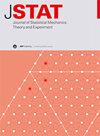具有长程相互作用的选民模型的老化特性
IF 1.9
3区 物理与天体物理
Q2 MECHANICS
Journal of Statistical Mechanics: Theory and Experiment
Pub Date : 2024-05-22
DOI:10.1088/1742-5468/ad41db
引用次数: 0
摘要
我们研究了在排序动力学中具有长程相互作用的一维投票者模型的老化特性。在这个系统中,一个位于网格顶点 i 的代理复制了另一个位于距离 r 处的代理的状态,这个代理是以概率......随机选择的。利用分析和数值方法,我们计算了一个变量 Si 在 s 时刻的状态与另一个变量 r 在 t 时刻的状态之间的双时相关函数( )。在 t 时刻,一个代理对其在 s 时刻的前状态的记忆,用自相关函数 表示,在 α > 1 时代数衰减为 ,其中 L 是时间递增的相干长度,λ 是费雪-胡斯指数。我们发现,当 α > 2 时,λ = 1;当 α > 2 时,λ = 1。而对于 ,则会出现指数衰减,就像在平均场中一样。那么,与相关伊辛模型的已知情况相反,在这里我们发现 λ 会随着 α 的减小而增大。同样,对于Ⅳ,我们可以得到Ⅴ,此时调节两时相关性的长度与相干长度的差别为Ⅴ。本文章由计算机程序翻译,如有差异,请以英文原文为准。
Aging properties of the voter model with long-range interactions
We investigate the aging properties of the one-dimensional voter model with long-range interactions in its ordering kinetics. In this system, an agent, , positioned at a lattice vertex i, copies the state of another one located at a distance r, selected randomly with a probability . Employing both analytical and numerical methods, we compute the two-time correlation function ( ) between the state of a variable Si at time s and that of another one, at distance r, at time t. At time t, the memory of an agent of its former state at time s, expressed by the autocorrelation function , decays algebraically for α > 1 as , where L is a time-increasing coherence length and λ is the Fisher–Huse exponent. We find λ = 1 for α > 2, and for . For , instead, there is an exponential decay, as in the mean field. Then, in contrast with what is known for the related Ising model, here we find that λ increases upon decreasing α. The space-dependent correlation obeys a scaling symmetry for α > 2. Similarly, for , one has , where the length regulating two-time correlations now differs from the coherence length as , with .
求助全文
通过发布文献求助,成功后即可免费获取论文全文。
去求助
来源期刊
CiteScore
4.50
自引率
12.50%
发文量
210
审稿时长
1.0 months
期刊介绍:
JSTAT is targeted to a broad community interested in different aspects of statistical physics, which are roughly defined by the fields represented in the conferences called ''Statistical Physics''. Submissions from experimentalists working on all the topics which have some ''connection to statistical physics are also strongly encouraged.
The journal covers different topics which correspond to the following keyword sections.
1. Quantum statistical physics, condensed matter, integrable systems
Scientific Directors: Eduardo Fradkin and Giuseppe Mussardo
2. Classical statistical mechanics, equilibrium and non-equilibrium
Scientific Directors: David Mukamel, Matteo Marsili and Giuseppe Mussardo
3. Disordered systems, classical and quantum
Scientific Directors: Eduardo Fradkin and Riccardo Zecchina
4. Interdisciplinary statistical mechanics
Scientific Directors: Matteo Marsili and Riccardo Zecchina
5. Biological modelling and information
Scientific Directors: Matteo Marsili, William Bialek and Riccardo Zecchina

 求助内容:
求助内容: 应助结果提醒方式:
应助结果提醒方式:


